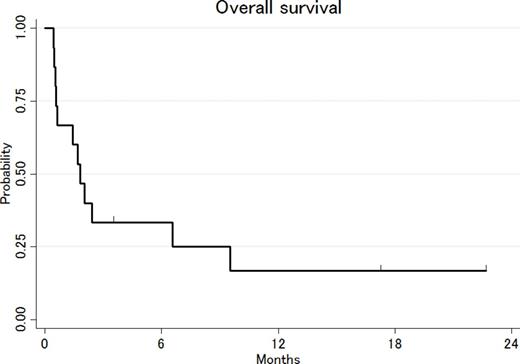Abstract
Purpose: We assessed the survival outcome of patients with anaplastic large cell lymphoma (ALCL) who experienced disease progression or relapse after first line and subsequent therapy. We sought to evaluate the impact of brentuximab vedotin (BV), and survival outcome of patients with ALCL who experienced progression after BV.
Patients and Methods: A total of 176 patients (74 ALK+, 102 ALK-) initially diagnosed between 1999 and 2014 were retrospectively analyzed. Progression-free survival (PFS) and overall survival (OS) after the progression/relapse following first-line chemotherapy (PFS1 and OS1), after first salvage therapy (PFS2 and OS2) and after second salvage therapy (PFS3 and OS3) were calculated. Outcome was separately analyzed according to the ALK status focusing on the use of BV.
Results: The median age of the patients was 50 (range: 18-89). With a median follow up of 64 months, 111 patients (38 ALK+, 73 ALK-) experienced progression/relapse after the first-line therapy, of which 4 ALK- patients were post upfront stem cell transplant (SCT). Thirty and 15 patients eventually underwent autologous and allogeneic SCT after salvage chemotherapy, respectively. The median PFS1 and OS1 in patients with ALK+ALCL and ALK-ALCL were 8.4 and 28.5 months, and 13.1 and 47.7 months, respectively. In patients with ALK+ALCL, the median PFS1, PFS2 and PFS3 were 53.6, 5.2 and 2.3 months, respectively. The median OS1, OS2 and OS3 were not reached, 47.3 and 6.1 months, respectively. In patients with ALK-ALCL, the median PFS1, PFS2 and PFS3 were 12.9, 3.0 and 2.0 months, respectively. The median OS1, OS2 and OS3 were 54.3, 10.8 and 5.8 months, respectively. Interestingly, there were no significant difference in PFS2 between ALK+ALCL and ALK-ALCL. However, OS2 was significantly longer in patients with ALK+ALCL, suggesting possibly continued chemosensitivity of recurrent ALK+ALCL. A total of 30 patients received BV in 1st salvage (15 patients) and after 2nd salvage (15 patients).The use of BV at 1st salvage was associated with significantly longer PFS2 and OS2 both in patients with ALK-ALCL but not with ALK+ALCL likely due to small number of cases. Mutivariate analysis adjusting baseline PIT risk factors and the duration of the response to first line therapy revealed that use of BV (at any point in the salvage setting) is significantly associated with longer OS2 (HR: 0.43, 95%CI: 0.23-0.80). Overall, 12 patients experienced relapse/progression after BV treatment. The median OS after BV failure was 1.4 months (95%CI: 0.5-9.5 months) (Figure).
Summary: Survival outcome for relapsed/refractory patients with ALK+ and ALK- patients is improved with BV. However, survival outcome after BV failure is very poor. A new treatment strategies to consolidate or maintain the response after BV and to develop more safe and better therapeutic options are needed.
Fanale:Merck: Honoraria, Membership on an entity's Board of Directors or advisory committees, Research Funding; BMS: Research Funding; Celgene: Honoraria, Membership on an entity's Board of Directors or advisory committees, Research Funding; Takeda: Honoraria, Research Funding; Infinity: Membership on an entity's Board of Directors or advisory committees; Spectrum: Membership on an entity's Board of Directors or advisory committees; Seattle Genetics: Honoraria, Research Funding; Genentech: Research Funding; Medimmune: Research Funding; Novartis: Research Funding; Bayer: Membership on an entity's Board of Directors or advisory committees; Amgen: Membership on an entity's Board of Directors or advisory committees; Molecular Templates: Research Funding; ADC Therapeutics: Research Funding; Onyx: Research Funding; Gilead: Research Funding. Westin:Spectrum: Research Funding. Nastoupil:Celgene: Honoraria; Genentech: Honoraria; AbbVie: Research Funding; Janssen: Research Funding; TG Therapeutics: Research Funding. Wang:Celgene: Research Funding.
Author notes
Asterisk with author names denotes non-ASH members.


This feature is available to Subscribers Only
Sign In or Create an Account Close Modal